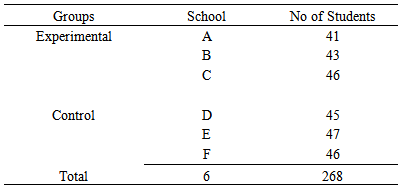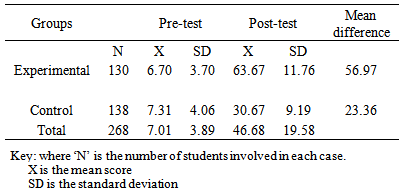-
Paper Information
- Previous Paper
- Paper Submission
-
Journal Information
- About This Journal
- Editorial Board
- Current Issue
- Archive
- Author Guidelines
- Contact Us
Education
p-ISSN: 2162-9463 e-ISSN: 2162-8467
2014; 4(3): 74-77
doi:10.5923/j.edu.20140403.03
Effect of Five Phases of Constructivist Instructional Model (CIM) on Junior Secondary School Two (JSS 2) Students’ Cognitive Achievement and Interest in Basic Science and Mathematics in Cross River State of Nigeria
Esther Etop Ekon, Cecilia Olunwa Ekwueme, Anne Meremikwu
Department of Curriculum and Teaching, Faculty of Education, University of Calabar, Cross River, Nigeria
Correspondence to: Cecilia Olunwa Ekwueme, Department of Curriculum and Teaching, Faculty of Education, University of Calabar, Cross River, Nigeria.
| Email: |  |
Copyright © 2014 Scientific & Academic Publishing. All Rights Reserved.
This study was designed to investigate the effect of five phases of constructivist instructional model (CIM) on Junior Secondary School two (JSS 2) students’ cognitive achievement and interest in basic science and mathematics in Calabar municipality of Nigeria. The key objects here in this study includes the effect of instructional models on students’ achievement and interest in mathematics and basic science. To achieve this, two research questions guided the study. Conceptual and theoretical studies were reviewed. A non-equivalent pre-test post-test quasi-experimental design was used. Two hundred and sixty-eight (268) participated in the study out of a total population of about 4,280 JSS 2 students in state government-owned schools using a simple random sampling technique. Three schools were randomly assigned to experimental and control groups respectively. The 130 experimental group students were exposed to the use of the five phases of the Constructivist Instructional Model (CIM) while conventional method was used for the 138 control group students. Two instruments: Cognitive Achievement Test (CAT) and Basic Science and Mathematics Interest Inventory (BSMII) were developed and administered to the students. Mean Scores and standard deviations were used to answer the research questions. The result revealed significant difference in mean achievement and interest scores of the students in the experimental group. Since the use of this CIM enhanced their academic achievement and interest, new basic science and mathematics curriculum that is constructivist oriented is recommended.
Keywords: Constructivist Instructional Model (CIM), Cognitive Achievement, Interest, Basic Science and Mathematics
Cite this paper: Esther Etop Ekon, Cecilia Olunwa Ekwueme, Anne Meremikwu, Effect of Five Phases of Constructivist Instructional Model (CIM) on Junior Secondary School Two (JSS 2) Students’ Cognitive Achievement and Interest in Basic Science and Mathematics in Cross River State of Nigeria, Education, Vol. 4 No. 3, 2014, pp. 74-77. doi: 10.5923/j.edu.20140403.03.
Article Outline
1. Introduction/Review of Relevant Literature
- The importance of basic Science and mathematics in secondary schools can not be over emphasized in Nigeria. They are the life wire for technological advancement as stated in Ekwueme & Meremikwu (2013) that no nation can hope to achieve any measure of scientific and technological advancement without proper foundation in school mathematics and science. Despite this importance, students are not performing up to expectation in these important subjects as seen from both junior and senior certificate examination results(West African Examination Council’s Chief Examiners’ yearly reports, 2007 – 2012). This had been a concern for parents, educators and some concerned students (Bassey 2002). Various steps had been taken by government and educational planners in Nigeria in an attempt to overcome the problem of poor performance of students in these subjects. For instance, the government has strengthened its policy on the school supervision to make teachers more committed to duty, encouraged science teachers through science allowance and encouraged teachers to attend conferences and seminars and in-service courses. Unfortunately, the efforts have only yielded minimal result. In recognition of this importance as well as indispensability of basic science and mathematics to human and national development and these problems that emphasis is now placed on instruction for their communication at all levels of education system (Ekon, 2013). Many learning strategies have been proposed such as learning by doing, problem solving, and enquiry. Nwosu and Nzewi (1998) stated that among the methods advocated for effective teaching and learning are co-operative learning, problem-solving and constructivism. Constructivism is a teaching strategy which holds the view that knowledge are personally constructed and reconstructed by the learner based on his prior knowledge or experiences. It is a strategy of learning based on the belief that knowledge is not a thing that can be simply given or transferred by the teacher in front of the classroom to learners seated at their desks. Rather, knowledge should be constructed by the learners through an active mental developmental process. It also allows the students to interact with themselves, explore and work in groups, making meaning of tasks and setting out to solving problems that are perplexing to them (Tim as cited in Mandor, 2002).There are several Constructivist Instructional Models as sited in Ekon (2013) that are useful in helping learners reconstruct knowledge based on their experiences which include the five phases of constructivist models that is used in this study. This instructional model is activity-based, students-centered, interactive oriented. The five phases of Constructivist Instructional Model was proposed by the Biological Science curriculum as adopted in this study for the teaching of Basic Science and mathematics. The phases are:-Engagement stage which is problem identification stage;Exploration stage which is the experimenting and problem solving stage;Explanation stage which is the classification stage;Elaboration stage which is the generalization stage;Evaluation stage which is the signal feedback stage.It is therefore worthwhile to investigate the efficacy of this method compared to the normal method (conventional) as used by most of our teachers in teaching basic science and mathematics in our schools.Ekon (2013) stated in her study that constructivist model create room for better cognitive achievement in that they allow students to discover meaning of basic science and mathematics concepts. Eze (2005) stated that students in secondary schools learn better and score higher marks when activity based approach is used in teaching science and the approach encourages mastery and retention of concepts learnt.Brunner’s theory of learning and constructivism stated that learning is an active process in which learners construct new ideas based on discovery or experience. This theory is relevant to this study in that the 5 phases of CIM used in this study should help learners discover meaning of concepts personally through the manipulation of the teaching materials provided by the teachers in the classroom. To this end, teachers are expected to lay more emphasis on important concepts which help learners to learn and apply whatever they have learnt beyond the classroom setting.
2. Purpose of Study
- The study is designed to determine the effect of five phases of Constructivists Instructional Model on Junior secondary two students cognitive achievement and interest in basic science and mathematics in Calabar Municipality.Specifically, the study seeks to find out:-(i) If five phases of CIM will lead to greater cognitive achievement for Junior secondary two students in basic science and mathematics than the conventional method.(ii) If there will be any effect of the five phases of CIM on the students’ interest in basic science and mathematics.
3. Research Methodology
- The study posed two research questions namely:-(i) How does the five phases of CIM affect the junior secondary two students’ cognitive achievement in basic science and mathematics compared to the conventional method?(ii) To what extent do the five phases of CIM affect the junior secondary two students’ interest in basic science and mathematics?The research design used for this study was quasi-experimental design since intact classes were involved. The pre-test post-test non-equivalent control group was adopted. The study was carried out in Calabar municipality of Cross River State since the researchers are familiar with the area and can adequately monitor and supervise the experiment. All the junior secondary two basic science and mathematics students in the sixteen state-owned secondary schools in Calabar Municipality in 2011/2012 academic session formed the population.The choice of JSS 2 is based on the fact that the topics chosen for treatment were selected from the core curriculum of the Federal ministry of Education for JSS 2.Random sampling technique was used for sample selection. Out of the sixteen schools, six schools were randomly selected, three each to the experimental and control groups as shown in table 1.
|
4. Result & Discussion
4.1. For Research Question l
- (i) How does the five phases of CIM affect the junior secondary two students’ cognitive achievement in basic science and mathematics compared to the conventional method?
|
|
4.2. For Research Question II
- To what extent does the five phases of CIM affect the JSS 2 students’ interest in Basic Science and Mathematics.The effect of the 5 phases of CIM on students’ interest in the two subjects (Basic Sciences and Mathematics) is shown in table 4. The experimental group students who were taught using the 5 phases of CIM were more interested in the subjects. They obtained a mean interest score of 63.57. This result indicated that the instructional method has a positive impact on the students in that it spurred the students’ interest in those subjects. The moderate standard deviation 7.46 with a high mean interest scores of 63.57 indicated that the effect of the instructional model was realized compared to those in control group who had a low mean interest score of 15.98 with a standard deviation of 5.08 (higher than 1/5 of the maximum possible mark) which indicated a non mastery of the Instructional concepts. Since the standard deviation in the control group was higher than 1/5 of the maximum possible mark, it means that there was a marked difference in their inter-individual interest scores which means that their scores in the control group were far apart.
|
5. Discussion of the Educational Importance of the Study
- The result of this study has some implications for teachers, students, policy makers, researchers and curriculum developers. Efforts aimed at improving students’ achievement in Basic Science and Mathematics in junior classes should be broadened to address all important factors that contribute to students’ interest and achievement.Teachers should be using activity-based child-centered instructional methods like the constructivist instructional models for more effective teaching which in turn will lead to excellent cognitive achievement and interest in basic science and mathematics. When one considers the implication of the theories of learning, Bruner, Piaget and Dewey, stressed the use of activity-based instructional methods in the classroom and that these methods would allow learners to discover knowledge themselves through the several activities they will be performing. Knowledge can easily be gained through these methods rather than being spoon-fed by the teacher (as is being done in the conventional method) who is seen as the custodian of knowledge.Policy makers are expected to use the information provided by this study as a basis for taking decision on the best instructional methods( like activity-oriented, child-centered and problem solving methods) to be adopted in Nigerian junior secondary school basic science and mathematics curriculum as opposed to using the conventional method. This is so, since the activity-based methods are aimed at making basic science and mathematics learning interesting and exciting. The curriculum developers in the Ministry of Education should encourage refreshers’ courses or re-training programmes to broaden science and mathematics teachers knowledge on the use of activity-based child centered instructional method like the five phases of CIM.
 Abstract
Abstract Reference
Reference Full-Text PDF
Full-Text PDF Full-text HTML
Full-text HTML


